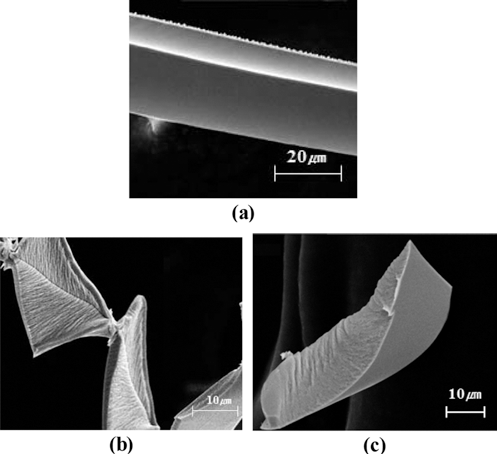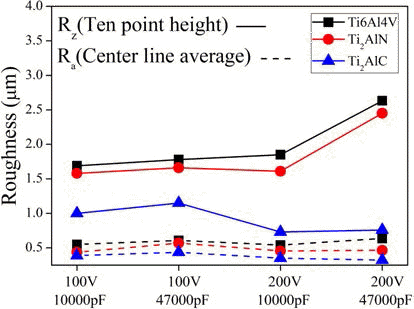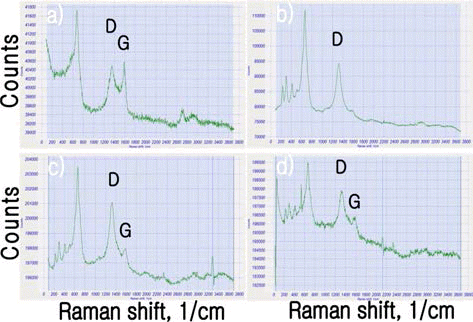Search
- Page Path
- HOME > Search
- [Korean]
- Preparation of Nanosized Gd2O3:Eu3+ Red Phosphor Coated on Mica Flake and Its Luminescent Property
- Se-Min Ban, Jeong Min Park, Kyeong Youl Jung, Byung-Ki Choi, Kwang-Jung Kang, Myung Chang Kang, Dae-Sung Kim
- J Korean Powder Metall Inst. 2017;24(6):457-463. Published online December 1, 2017
- DOI: https://doi.org/10.4150/KPMI.2017.24.6.457

- 755 View
- 3 Download
- 1 Citations
-
 Abstract
Abstract
 PDF
PDF Nanosized Gd2O3:Eu3+ red phosphor is prepared using a template method from metal salt impregnated into a crystalline cellulose and is dispersed using a bead mill wet process. The driving force of the surface coating between Gd2O3:Eu3+ and mica is induced by the Coulomb force. The red phosphor nanosol is effectively coated on mica flakes by the electrostatic interaction between positively charged Gd2O3:Eu3+ and negatively charged mica above pH 6. To prepare Gd2O3:Eu3+-coated mica (Gd2O3:Eu/mica), the coating conditions are optimized, including the stirring temperature, pH, calcination temperature, and coating amount (wt%) of Gd2O3:Eu3+. In spite of the low luminescence of the Gd2O3:Eu/mica, the luminescent property is recovered after calcination above 600°C and is enhanced by increasing the Gd2O3:Eu3+ coating amount. The Gd2O3:Eu/mica is characterized using X-ray diffraction, field emission scanning electron microscopy, zeta potential measurements, and fluorescence spectrometer analysis.
-
Citations
Citations to this article as recorded by- Optimization of dispersed LaPO4:Tb nanosol and their photoluminescence properties
Mahboob Ullah, Se-Min Ban, Dae-Sung Kim
Optical Materials.2019; 97: 109366. CrossRef
- Optimization of dispersed LaPO4:Tb nanosol and their photoluminescence properties
- [Korean]
- Evaluation of Material Characteristics with Sintering Temperature in Ti2AlC MAX Phase Material using Spark Plasma Sintering Method
- Chang-Hun Lee, Gyung Rae Baek, Hee Sang Jung, Young-Keun Jeong, Myung Chang Kang
- J Korean Powder Metall Inst. 2015;22(3):175-180. Published online June 1, 2015
- DOI: https://doi.org/10.4150/KPMI.2015.22.3.175

- 856 View
- 7 Download
- 1 Citations
-
 Abstract
Abstract
 PDF
PDF In this study, ternary compound Max Phase Ti2AlC material was mixed by 3D ball milling as a function of ball milling time. More than 99.5 wt% pure Ti2AlC was synthesized by using spark plasma sintering method at 1000, 1100, 1200, and 1300°C for 60 min. The material characteristics of synthesized samples were examined with relative density, hardness, and electrical conductivity as a function of sintering temperature. The phase composition of bulk was identified by X-ray diffraction. On the basis of FE-SEM result, a terraced structures which consists of several laminated layers were observed. And Ti2AlC bulk material obtained a vickers hardness of 5.1 GPa at the sintering temperature of 1100°C.
-
Citations
Citations to this article as recorded by- Synthesis and reaction path of Ti‐Al‐C MAX phases by reaction with Ti‐Al intermetallic compounds and TiC
Hojun Lee, Si Yeon Kim, Young‐In Lee, Jongmin Byun
Journal of the American Ceramic Society.2023; 106(12): 7230. CrossRef
- Synthesis and reaction path of Ti‐Al‐C MAX phases by reaction with Ti‐Al intermetallic compounds and TiC
- [Korean]
- Machining Characteristics of Micro Structure using Single-Crystal Diamond Tool on Cu-plated Mold
- Chang-Eui Kim, Eun-chae Jeon, Tae-Jin Je, Myung Chang Kang
- J Korean Powder Metall Inst. 2015;22(3):169-174. Published online June 1, 2015
- DOI: https://doi.org/10.4150/KPMI.2015.22.3.169

- 861 View
- 2 Download
- 2 Citations
-
 Abstract
Abstract
 PDF
PDF The optical film for light luminance improvement of back light unit that is used in light emitting diode/liquid crystal display and retro-reflective film is used as luminous sign consist of square and triangular pyramid structure pattern based on V-shape micro prism pattern. In this study, we analyzed machining characteristics of Cu-plated flat mold by shaping with diamond tool. First, cutting conditions were optimized as V-groove machining for the experiment of micro prism structure mold machining with prism pattern shape, cutting force and roughness. Second, the micro prism structure such as square and triangular pyramid pattern were machined by cross machining method with optimizing cutting conditions. Variation of Burr and chip shape were discussed by material properties and machining method.
-
Citations
Citations to this article as recorded by- Investigation of ultra-precision planing process to fabricate high luminance retroreflector based on cutting force and tool vibration analysis
Ji-Young Jeong, Jun Sae Han, Chung-Mo Kang, Eun-Ji Gwak, Doo-Sun Choi, Tae-Jin Je
Scientific Reports.2022;[Epub] CrossRef - Precision Cutting of the Molds of an Optical Functional Texture Film with a Triangular Pyramid Texture
Huang Li, Zhilong Xu, Jun Pi, Fei Zhou
Micromachines.2020; 11(3): 248. CrossRef
- Investigation of ultra-precision planing process to fabricate high luminance retroreflector based on cutting force and tool vibration analysis
- [Korean]
- Characteristics of Material Properties and Machining Surface in Electrical Discharge Machining of Ti2AlN and Ti2AlC Materials
- Eui-Song Choi, Chang-Hoon Lee, Gyung-Rae Baek, KwangHo Kim, Myung Chang Kang
- J Korean Powder Metall Inst. 2015;22(3):163-168. Published online June 1, 2015
- DOI: https://doi.org/10.4150/KPMI.2015.22.3.163

- 752 View
- 1 Download
- 1 Citations
-
 Abstract
Abstract
 PDF
PDF Ti alloys are extensively used in high-technology application because of their strength, oxidation resistance at high temperature. However, Ti alloys tend to be classified very difficult to cut material. In this paper, The powder synthesis, spark plasma sintering (SPS), bulk material properties such as electrical conductivity and thermal conductivity are systematically examined on Ti2AlN and Ti2AlC materials having most light-weight and oxidation resistance among the MAX phases. The bulk samples mainly consisted of Ti2AlN and Ti2AlC materials with density close to theoretical value were synthesized by a SPS method. Machining characteristics such as machining time, surface quality are analyzed with measurement of voltage and current waveform according to machining condition of micro-electrical discharge machining with micro-channel shape.
-
Citations
Citations to this article as recorded by- Comparative Study on Ablation Characteristics of Ti-6Al-4V Alloy and Ti2AlN Bulks Irradiated by Femto-second Laser
Ki Ha Hwang, Hua Feng Wu, Won Suk Choi, Sung Hak Cho, Myungchang Kang
Journal of the Korean Society of Manufacturing Process Engineers.2019; 18(7): 90. CrossRef
- Comparative Study on Ablation Characteristics of Ti-6Al-4V Alloy and Ti2AlN Bulks Irradiated by Femto-second Laser
- [Korean]
- Powder Sintering Characteristics of Carbon Nanotubes Reinforced SKD11 Tool Steel Sintered by Spark Plasma Sintering
- Je-Se Moon, Sung-Sil Jung, Dae-Yeol Lee, Young-Keun Jeong, Myung Chang Kang, Chun-Dal Park, Kook-Tae Youn
- J Korean Powder Metall Inst. 2015;22(3):157-162. Published online June 1, 2015
- DOI: https://doi.org/10.4150/KPMI.2015.22.3.157

- 681 View
- 3 Download
- 1 Citations
-
 Abstract
Abstract
 PDF
PDF SKD11 (ASTM D2) tool steel is a versatile high-carbon, high-chromium, air-hardening tool steel that is characterized by a relatively high attainable hardness and numerous, large, chromium rich alloy carbide in the microstructure. SKD11 tool steel provides an effective combination of wear resistance and toughness, tool performance, price, and a wide variety of product forms. Adding of CNTs increased the performance of mechanical properties more. 1, 3 vol% CNTs was dispersed in SKD11 matrix by mechanical alloying. SKD11 carbon nanocomposite powder was sintered by spark plasma sintering process. FE-SEM, HR-TEM and Raman analysis were carried out for the SKD11 carbon nanocomposites.
-
Citations
Citations to this article as recorded by- Study on Effects of Mold Temperature on the Injection Molded Article
J.-H. Han, Y.-C. Kim
Archives of Metallurgy and Materials.2017; 62(2): 1271. CrossRef
- Study on Effects of Mold Temperature on the Injection Molded Article
TOP
 KPMI
KPMI


 First
First Prev
Prev


